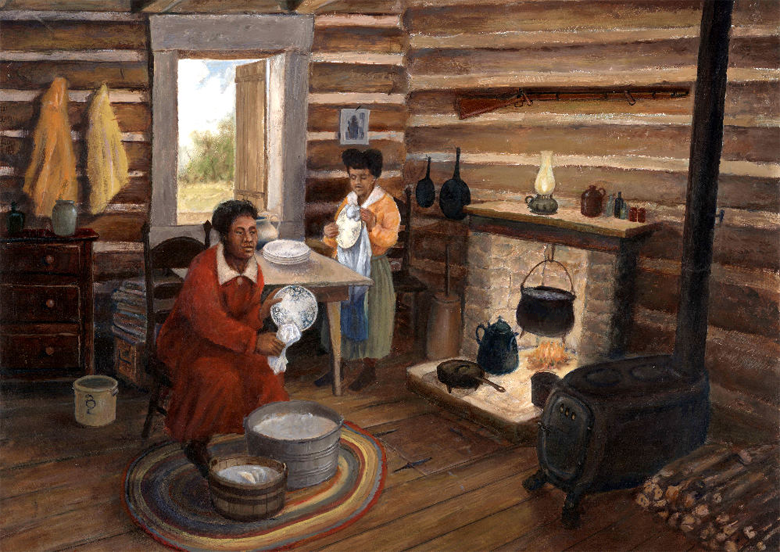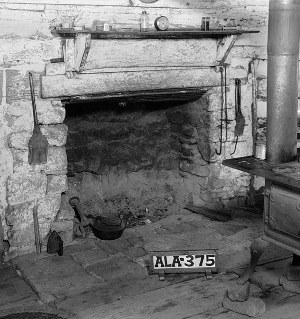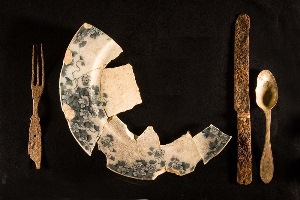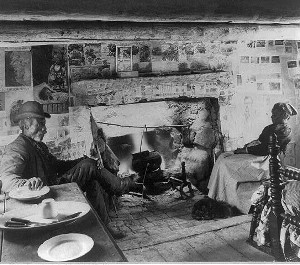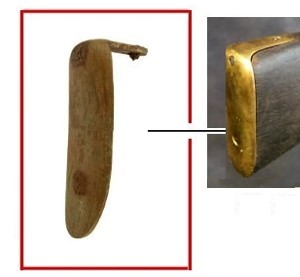Inside the Williams House
|
This painting depicts the inside of the Williams cabin, looking from the doorway toward the northeast corner and the fireplace on the east wall. The layout of the house is surmised from the locations of foundation stones in relation to the chimney base. Depicting the house as a log cabin is conjectural, of course, but this interpretation is based on strong circumstantial evidence. Almost all of the items displayed in the cabin can be linked to particular artifacts recovered on the farm, and the material culture denotes a family that is economically sound but living a modest lifestyle typical of small rural farmers in the late nineteenth century. This scene is a warm autumn evening as Sarah and her 10-year-old daughter, Mattie, are washing the dishes after dinner. Ransom and the others are out on the porch, doing their best to avoid washing dishes. It is nearly sunset, and the interior is illuminated with natural light coming from the open doorway (behind the viewer) and the small window on the opposite wall. The small fire in the fireplace adds a little more light, but the kerosene lantern on the chimney mantle is lit so they will still be able to see after the sun goes down. Sturdily built out of local limestone rocks, the fireplace is the focal point for many activities each day. The tin pot sits closest to the fire to keep the last remaining cups of coffee warm, while the cast iron dutch oven and a small iron pot have been pulled farther away to cool down. The big tripod pot is hanging over the fire to heat up dishwater. Even though they recently purchased a small two-burner wood stove, Sarah still prefers to cook most meals in the hearth, a well-honed skill she learned from her mother. The wood stove radiates too much heat throughout the cabin sometimes, so they will not use it until later on when the weather turns colder. But the fall weather is unpredictable this time of year, and several blankets are stacked on a box under the window until they are needed, and light jackets hang on hooks along the walls. Dishwashing is not a particularly fun chore, but the mother-daughter team has developed a process that limits the time they spend at it. After dinner, they pull the table off to the side near the window and began heating the dishwater. They scrub the plates clean and feed the remaining scraps to the dogs. They give the silverware a quick rinse and then put the utensils into the 3-gallon crock jar, setting it aside for last. Sarah sits in the middle of the room, with two wash tubs and the table within arm’s reach, working over a tightly woven rug that catches any excess water to avoid wetting the floor. Sarah scrubs the dishes clean in the large metal tub, which is filled with hot soapy water. She then puts the dishes into the smaller wooden half-barrel tub filled with clean warm rinse water. She pulls each dish out, lets it drip-dry for a few seconds, and then hands them to Mattie for drying. After drying a batch of dishes, Mattie walks across the room and places them in the dish cabinet on the opposite wall (out of view to the right). Hanging on the wall behind Mattie’s head is an unframed picture of Sarah’s father, one of only a handful of treasured photographs the family possesses. Hanging nearby are two iron skillets, and the butter churn sits next to the hearth. Ransom’s favorite gun, a well-used Civil War surplus Enfield rifle, hangs above the fireplace. Sarah would rather have a pretty picture above the fireplace, but that’s an argument she knows she can’t win. On the mantle next to the lantern, the family keeps a small jug of homemade salve—an old family remedy for cuts, bruises, blisters, bug bites, and lots of other ailments. They also keep some bottles of store-bought patent medicines there, along with one or two bottles of snuff tobacco. Both Ransom and Sarah occasionally use snuff, but Ransom prefers smoking his pipe. He chews tobacco, too, but he doesn’t do it often because Sarah thinks its disgusting and fusses at him. Sarah insists on keeping the interior of the cabin neat and clean, and she is proud that her daughters are learning her good housekeeping habits. The furnishings are sparse because there isn’t much extra room in the house. A dresser sits to the left of the window, where they always keep a two-gallon jug of water. Ransom doesn’t drink much, but he occasionally keeps a bottle of his favorite rye whiskey on the dresser as well. The west half of the cabin is where the family sleeps, with the adult beds on the floor and beds for the younger children in the overhead loft (out of view on the left). On the floor immediately in front of the fireplace is a small hinged door that allows access to the potato cellar. Underneath the trapdoor and set into the bedrock is a big box, 6x3-ft that extends 2 1/2 ft below the floor, where the family stores farm produce such as sweet potatoes and onions. It keeps perishable foods cool in the summer, but protects them from freezing in the winter. The potato cellar is located in the middle of the floor for easy access, but when the trapdoor is closed the floor space is available for the kitchen table and chairs or playing games by the fire. Since the farm has done well over the past decade, Ransom and Sarah have been able to buy some nicer things for themselves and their children. Sarah is wearing one of her dresses as she usually does for the evening meal, and she has on a necklace that Ransom bought her two years ago out of the Sears, Roebuck & Company catalog. The plates that they are washing were purchased just this year from the Montgomery Ward & Company catalog. Sarah wanted some pretty dinnerware for the family to enjoy, and she picked out the floral pattern herself. They ordered a full set of plates, cups, and saucers that came all the way from England! It was a little more expensive than some of the other china sets, but as Ransom and Sarah felt that they worked hard and deserved some nice things! |
|
